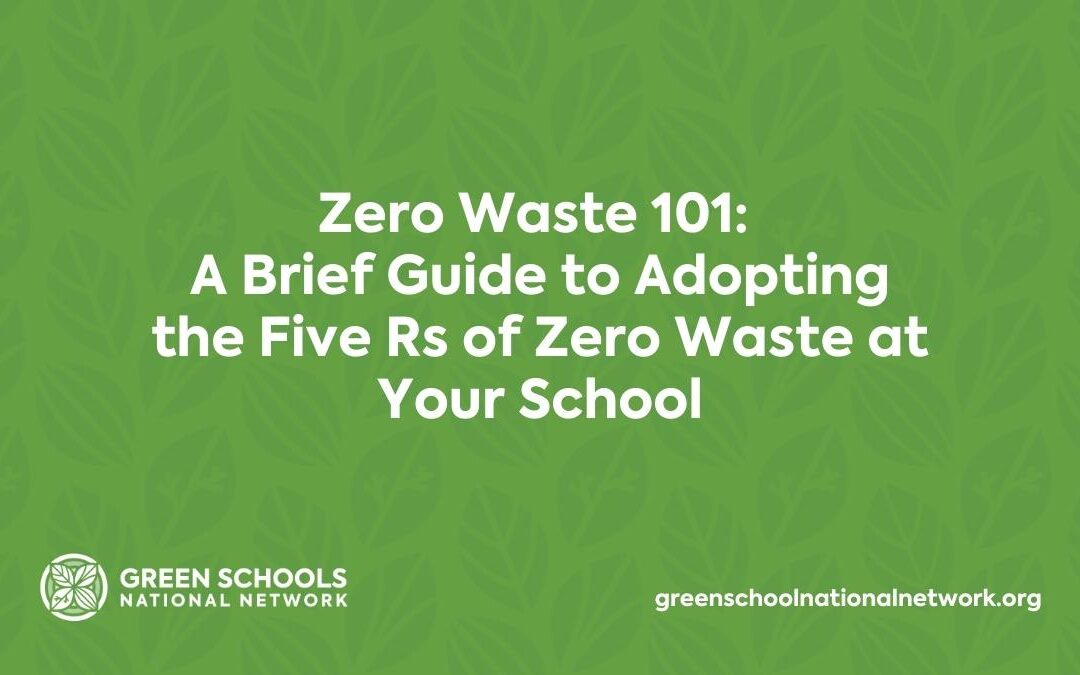Waste reduction is a big deal for K-12 schools – and schools produce a lot of waste! To meet sustainability goals, schools may add a recycling program, or even a composting program if local infrastructure allows. Now, more schools are beginning to aim for zero waste – that is, diverting all their waste so none ends up in landfills, incinerators, or the ocean. The concept of zero waste is easily summed up with five Rs: refuse, reduce, reuse, rot (compost), and recycle. Starting a zero-waste program is not just good for the environment but can also help your school save money through smarter purchasing decisions and lower transportation costs. This article covers what you need to do to get a zero-waste program off the ground as well as some ideas for implementing the five Rs of zero waste.
Set Yourself Up for Success
Making the shift to zero waste is a long-term commitment and is best accomplished in phases to ensure success and sustainability. Here are five steps to take to start your program off on the right foot.
Obtain buy-in from leadership. Successful programs depend on support from everyone in the school community to make zero waste part of your school’s culture. Pitch your idea to your principal, facilities and foodservice staff, and other relevant staff members first to ensure all the key players are onboard before moving forward.
Conduct a waste audit. A waste audit will help you establish a baseline by determining how much waste your school is current producing. From that baseline, you can identify how much of that waste can be diverted or eliminated and begin to come up with a set of strategies and initiatives you can implement immediately to show some early successes.
Have a plan for implementation. Zero waste is a journey, and you will need a road map to guide your decisions and programmatic efforts. As develop your plan, keep the following questions in mind:
- What are your zero-waste goals?
- What is your timeline for meeting these goals?
- What steps are your school already taking?
- What strategies and initiatives are you capable of taking on, now and in the future?
- Which of these new strategies and initiatives will deliver meaningful results?
- What steps do you need to take for each strategy and initiative to meet your goals?
- Who will lead the program? Note, there should be several leads to ensure program sustainability.
Establish a student green team. Student engagement will increase participation and enthusiasm for your zero-waste program and help shift school culture. Green team members can help with waste audits, serve as cafeteria and classroom bin monitors, and teach peers how to properly sort their waste.
Conduct training and education for the school community. Training and education are critical for program buy-in and sustainability. Trainings should be held yearly, ideally at the beginning of the school year. Training for members of the school community should cover why the program is important, how it impacts the school community, and how everyone can participate. Training for custodial staff and student monitors should cover program benefits, procedures for sorting waste, how to avoid bin contamination, and how to handle each bin’s contents. Classroom lesson plans and teaching materials on the five Rs can reinforce zero-waste concepts and help further student understanding.
Tips and Suggestions for Implementing the Five Rs of Zero Waste
Not sure where to start when it comes to implementing a zero-waste program? Rest assured, there’s no right or wrong way to approach zero waste. These tips and suggestions offer some easy ways for putting the five Rs of zero waste into action at your school.
- Implement purchasing practices that prioritize recycled, reusable, and recyclable products. Only purchase in quantities that you will use during the school year.
- Establish consistent signage, colors, and containers for recycling, composting, and trash. Many schools use color-coded bins with easy-to-read labels and signage posted on or above the bins.
- Designate an area in classrooms to collect reusable materials like paper scraps, paper towel rolls, fabric, and yarn scraps for arts and crafts projects.
- Hold schoolwide trash reduction competitions. Weigh the amount of trash created by each grade level and see which one produced the least waste.
- Hold waste-free class parties. Assemble a classroom kit of reusable plates, cups, and utensils that can be washed and reused after parties.
- Implement weekly waste-free lunches. For students who bring lunch from home, encourage the use of reusable lunch bags and food containers. For those who purchase lunch at school, encourage taking only as much food as they intend to eat.
- Start a food share table in the cafeteria. Students can leave whole or unopened packaged food they don’t want on the table and can take items from the table that appeal to them. Food left over after meals can be donated or reused in the cafeteria.
Zero waste is one of the practices highlighted in our GreenPrint. Download the GreenPrint and discover more best practices for healthy, equitable, and sustainable facilities and operations.

